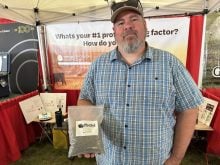Considering how the 2016 growing/harvest season went, there may be a real crunch this spring to first find and then get fertilizer applied at seeding, but if you’re thinking it might be a good idea to get a jump on workload and apply fertilizer this winter on snow or frozen ground — DON’T.
That’s the advice from long-time Western Canada soil researcher Rigas Karamanos.
“With a wet fall in many parts of Western Canada which delayed harvest, many producers may not have got as much fall field work done as they would have liked,” says Karamanos, senior agronomist for Koch Fertilizer Canada. “And if products are available now, some producers might be thinking they’ll catch up on their field work and broadcast apply fertilizer over winter. It’s just not a good idea for a few reasons.”
Read Also

Cancer agency reclassifies another herbicide ‘probably carcinogenic’
The WHO’s cancer research agency has now put atrazine, a herbicide well known to corn growers, in the same potential-hazard category where the agency put glyphosate.
First of all, nitrogen fertilizer that sits in snow or even on frozen ground for a few months could result in nitrogen losses as high as 40 to 50 per cent, says Karamanos. And depending on the blend and rate applied, come spring, winter-applied fertilizers could simply run-off the field and contribute to high nutrient levels in surface water.
Top dressing option
While getting crop nutrition applied before or at seeding may be preferred by many, Karamanos says, top dressing in-crop presents a viable option producers should consider, with no yield penalty.
Aside from the timing issue of getting everything applied at seeding, he says there may also be a real challenge this spring of finding sufficient supplies of fertilizer come April.

Karamanos says producers can apply what is needed to get the crop started at time of seeding, and then follow up during a four to six week window after seeding to get the remainder of the nutrients in the ground.
He says both liquid and granular products can be effective, applied in-crop as a top dressing. “You do need moisture, but assuming that’s there or coming, you can use any products quite effectively,” he says. “There is plenty of research that shows you can apply products in-crop and still optimize yields.”
With cereals it is important to apply top dress fertilizers by the first node stage (growth stage 31) and with canola, it should be applied by the sixth-leaf stage.
In applying a liquid fertilizer top dressing, Karamanos says it is important to use proper dribble band equipment (as opposed to a foliar spray system) to get nutrients through the standing crop and onto the soil where it is needed. “With liquid products, dribble applied, there might be some crop setback, but the crop will over come that,” he says.
He says it also might be a good year for farmers to consider delayed-release nitrogen fertilizer products, if they haven’t already. There are polymer-coated products as well as urease-inhibitor products that may have a fit as well. While he admits to being a bit partial to a Koch-carried product, Agrotain urease inhibitor, he says delayed or slow release products can be an effective way to manage field workload and reduce nitrogen loss under adverse conditions.
Karamanos says while there are a number of foliar products on the market, producers shouldn’t rely on them to supply sufficient macro-fertilizer ingredients such as nitrogen. At recommended application rates, they simply can’t deliver enough through a foliar treatment to make up for plant growth requirements.
So the take home message: don’t apply fertilizer on the snow, and if it doesn’t line up to get all nutrients applied at seeding, consider in-crop top dressing.
















